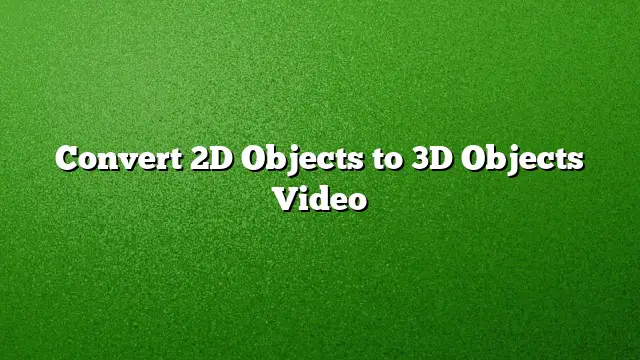Understanding 2D to 3D Conversion in AutoCAD
Transforming 2D drawings into 3D models using AutoCAD can enhance the design process significantly. This enablement supports engineers, architects, and designers in visualizing their projects more comprehensively. Follow the steps outlined below to navigate this conversion effectively.
Preparing Your 2D Drawing
Before starting the conversion, ensure your 2D drawing is clean and properly structured. It’s essential to check the following:
-
Layer Management: Organize your layers thoughtfully. Group similar elements together and avoid clutter. This will simplify the 3D process.
-
Closed Polylines: Ensure that the outlines of your shapes are closed polylines or shapes. Open shapes may lead to issues during the conversion.
- Scale and Units: Verify that your drawing’s scale and units are accurate. Misalignments can affect the final 3D representation.
Selecting the Right Commands
AutoCAD offers various commands for converting 2D objects into 3D. Familiarize yourself with these key commands:
-
EXTRUDE: This command adds depth to your 2D shapes, turning them into 3D solids. You can specify a height to define how thick the object will be.
-
REVOLVE: Use this command when creating 3D objects by rotating your 2D shape around a defined axis. This is particularly useful for creating cylindrical shapes.
- SWEEP: This command allows you to take a 2D profile and sweep it along a defined path to create complex shapes.
Step-by-Step Conversion Process
Follow these steps to convert your 2D drawing into a 3D object.
-
Open Your 2D Drawing: Begin by opening the 2D drawing file you wish to work with in AutoCAD.
-
Select a Shape to Convert: Click on the shape you want to turn into a 3D object. Ensure it is a closed polyline to avoid complications later on.
-
Apply the EXTRUDE Command:
- Type “EXTRUDE” in the command line and press Enter.
- Select the shape again if prompted.
- Input a height for the extrusion and hit Enter. You’ll see the shape rise in the Z-axis, becoming a solid in 3D.
-
Utilize the REVOLVE Command (if applicable):
- If you want to create a revolute object, pick the 2D profile.
- Type “REVOLVE” in the command line and press Enter.
- Specify the axis along which the object will revolve and define the angle (for a complete revolution, use 360).
- Employ SWEEP for Complex Paths:
- Choose the 2D profile and type “SWEEP”.
- Next, select the path along which you want to sweep the profile. This process creates intricate forms that aren’t possible with extrusion alone.
Refining Your 3D Model
Post-conversion adjustments can further enhance your 3D model’s appearance:
-
Manipulate the 3D Object: Use commands like MOVE, ROTATE, and SCALE to position and adjust the dimensions of your model.
-
Apply Materials and Textures: Access the material editor to apply different textures and finishes that provide your model with a more tangible look.
- Lighting and Rendering: To visualize your model better, introduce lighting elements and render the scene. This step can help you preview how the final product will look in a real-world environment.
Saving and Exporting Your 3D Model
Once you’ve created and refined your model, it’s crucial to save your work properly:
-
Save in the Correct Format: Use the ‘Save As’ function to keep your work saved in a compatible format for future editing.
- Export Options: If you plan to share your 3D model with stakeholders who don’t use AutoCAD, consider exporting in formats like STL or FBX, which are commonly used for 3D printing or animation software.
FAQ
Can I convert any 2D drawing into a 3D object?
Not all 2D drawings are suitable for conversion. The shapes must be closed and well-defined to ensure a successful transformation into a 3D model.
What if my shapes are not closed polylines?
If your shapes are open or disjointed, you’ll need to close them using commands like “PEDIT” to create closed polylines, which are necessary for successful extrusion or revolving.
Is AutoCAD 2025 compatible with older files?
Yes, AutoCAD 2025 maintains compatibility with previous versions, allowing you to open and convert older files without losing any data or functionalities.

